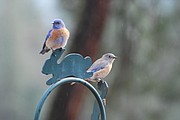Mineral County’s ‘bluebird buddies’ bring joy to many
When you see those little wooden bluebird houses on fence posts in Mineral County which have been providing joy for more people than you can imagine over the years in Mineral County, thank its “bluebird buddies.”
“I started ‘blue birding’ in about 1998 with a couple of boxes we hung on a portion of the ranch my husband’s grandparents owned,” said Jane Brockway of Superior.
Her passion has only grown. Jane has been active in Mountain Bluebird Trails, serving as the editor for the society’s newsletter, on the board of directors, and Banding Administrator for many years.
She also serves on the board of directors for the North American Bluebird Society. Jane monitors her trail of 80-plus boxes and also bands about 200-350 bluebirds a year.
Mineral County is prime habitat for the western bluebird at 2,760 feet elevation. The mountain bluebird prefers higher elevations starting at 5,000 feet and above, but in some areas here in Mineral County you may see both.
Westerns have a reddish-brown breast which contrasts with their predominately blue plumage and the Mountain is blue from head to tail. A beautiful cerulean blue you will never forget once you’ve seen one.
The bluebird is usually perceived as a symbol of joy and happiness to remind you of all the beauty of nature around you.
Bluebirds are insectivores during the nesting season. Doug and Dana Austin are grateful to ranchers and other landowners who let them put boxes on their fence posts.
“We noticed very old bluebird boxes in our Tarkio area. We loved the bluebirds we saw in our area as we drove in and out from the highway. We call it bluebird alley. Today we monitor 17 boxes and started about 15 years ago.”
“At the high point of my monitoring there were about 60 boxes I considered ‘mine’ from milepost 8 to St. Regis,” reported Nicki Clyde in St. Regis.
During the late 1970s there was a blue bird trail of houses that stretched 700 miles across Montana on Highway 200 using boxes built by enthusiasts but also hundreds that were built in the back of the Aylesworth Insurance office in Ronan.
The bluebird conservation movement in the west started by Art Ayelesworth and continues to this day.
This in part has increased the fledgling count bluebirds in Montana from 6 in 1976 to 17,567 by 1998.
“Probably my most recurrent memory, though, is the day I went out to monitor with my young son and his friend and our two dogs. I opened the top on a nest box and half a dozen young flying squirrels streamed out.
“The dogs chased and the boys and I laughed. It still makes me chuckle,” Clyde said.
“One can have a ‘trail’ with as few as 2 or 3 boxes to monitor,” said Dana Austin. “It’s just a matter of getting started.”
Through banding, and record keeping, the data has answered many questions, including that bluebirds don’t mate for life.
As for staying together for a whole nesting season or returning to the same box or area every year, sometimes they do.
Bluebirds typically live two to three years in the wild, but some as long as seven or eight years.
While some are uncertain where bluebirds winter, the Cornell Lab of Orintholgy says many winter in Arizona, West Texas or Mexico.



